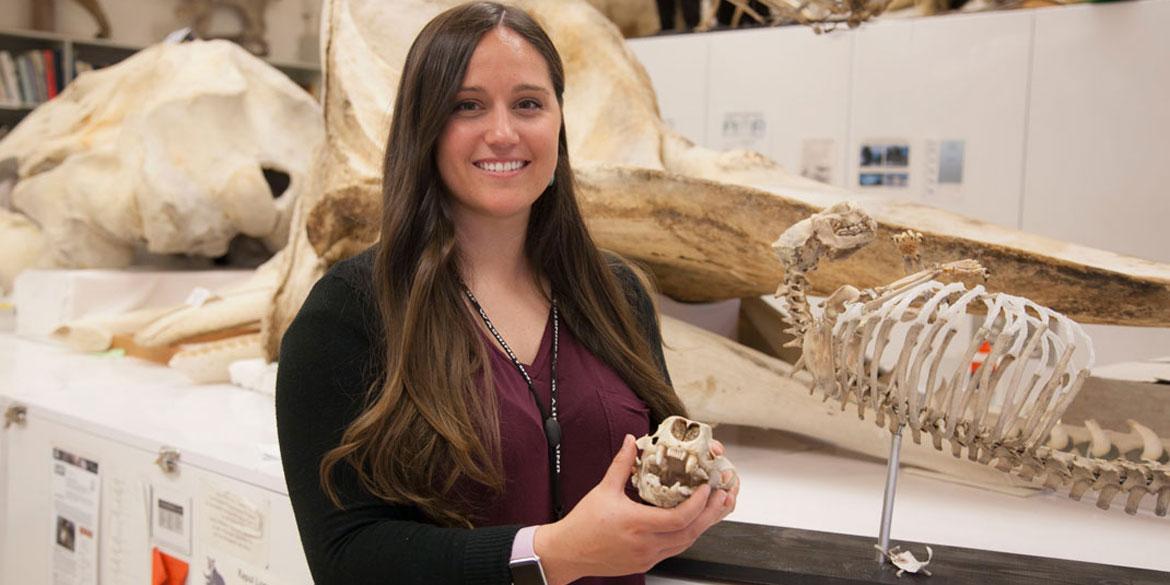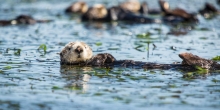Kristin Campbell is a recent graduate from the University of Washington Biology Department. She currently volunteers for the Burke Museum’s Mammalogy Collection and continues to research sea otter skull morphology and feeding ecology in the Santana Lab.
Robust jaws and crushing bites allow sea otters to specialize their diets
A sea otter’s survival depends on their ability to catch and eat prey. Unlike most marine mammals, sea otters lack a thick layer of blubber to insulate them from the frigid waters of the Pacific Ocean. Instead, they rely on dense fur and a very active metabolism to keep warm.
Sea otters have a diverse diet, eating anything from clams to sea urchins to crabs. However, while sea otter diets are diverse at a population level, individual sea otters can have highly specialized diets. This is especially true for the subspecies of sea otter living in the waters of southern California. Known as the southern sea otter, this subspecies lives in rocky environments where marine invertebrates are plentiful.
As the number of sea otters in a particular area grows, each sea otter must compete for food with its neighbor. To overcome this, individual southern sea otters start to specialize by eating specific prey species, alleviating the competition. In this way, southern sea otters act as diet specialists. However, this behavior is not observed in northern sea otters, the subspecies that lives in Washington, British Columbia, and Alaska.
In these mixed-sediment marine environments, sea otters quickly deplete their favorite prey, like sea urchins, and are left to forage mostly on bivalves, such as clams and mussels. Therefore, in contrast to southern sea otters, northern sea otters act as generalists.
Why are northern and southern sea otters behaving differently?
While previous research has found that habitat type and the diversity and abundance of prey influence this behavior, little is known about whether a sea otter’s anatomy and feeding performance plays a role in enhancing or restricting their ability to specialize on certain prey types. Specialized behaviors, like feeding on specific food items, are often associated with specialized morphologies, like the size and shape of an animal’s body or its skull.
Working with Dr. Sharlene Santana, curator of mammals at the Burke Museum, I set out to investigate whether differences in food-resource use in sea otters can be explained by differences in the size and shape of their skull and their ability to efficiently bite into prey.
I used more than 100 sea otter skulls from the Burke Museum’s Mammalogy collection to create mathematical models that allowed us to compare bite force, jaw strength, and skull size and shape differences between northern and southern sea otters.
Comparing the skulls of the two subspecies, we found subtle differences in skull size and shape between the northern and southern sea otters. However, these differences do not translate to significant differences in bite force.
This means that each subspecies has the potential to become a specialist or remain a generalist depending on prey availability, habitat characteristics, and competition. Southern sea otters specialize their diets, however, when conditions require.
Sea otters are keystone species in coastal ecosystems, but sadly they are also endangered. A better understanding of their adaptations is critical for their conservation.
By using museum specimens, we were able to identify anatomical performance differences between and within sea otter populations. We have gained valuable insight into how their ability to produce forceful bites might allow them to act both as generalists or specialists depending on environmental conditions.
Read Kristin's original article on the Burke's blog.
Read the study “Do differences in skull morphology and bite performance explain dietary specialization in sea otters?” in the Journal of Mammalogy

